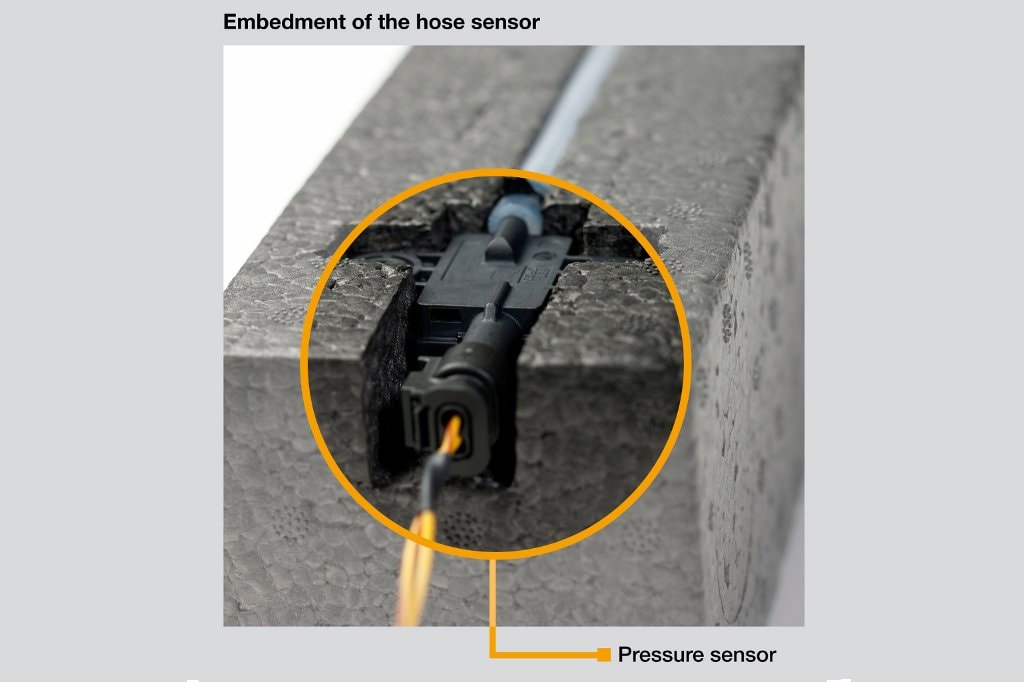Automotive supplier Continental today announced the introduction of a new pedestrian protection system designed to enhance the protection of pedestrians on the roads. The system features a special type of air hose connected to two pressure sensors which builds flexibly into the bumper.
"The sensor reliably recognizes collisions with pedestrians and supplies the safety systems with the information they need to trigger protective measures," said Scott Morell, passive safety engineering director for Continental's North American region.
Within 10-15 milliseconds of an impact, the active hood of the vehicle is triggered and raised by special actuators. This prevents the pedestrian who has been hit from being severely injured or killed by the impact with the hood and underlying engine block. The extra space provided between the hood and engine can considerably mitigate the consequences of the accident.
The pressure hose sensor has been developed by Continental in partnership with Daimler, and can be flexibly adapted to the shape of the chassis.
"This means that there are no restrictions on vehicle developers if they alter a vehicle's design – as part of a facelift, for example," said Morell. "What's more, the system's technology is extremely robust and offers high resolution and strong signal quality, which boosts the reliability of crash detection."
When a vehicle collides with an obstacle, the resulting pressure exerted on the hose through the front bumper and foam block creates a typical waveform that is detected by the two sensors at the ends of the hose and forwarded to an airbag control unit.
Crash algorithms in the analysis software and speed information from the vehicle's information network enable the type of collision to be identified in a hundredth of a second. This enables the rapid activation of protection systems, which are most effective in accidents in urban traffic with a pre-crash speed of no more than 34 mph (55 km/h) and a crash speed of between 12 (20 km/h) and 18 mph (29 km/h).
"The sensor reliably recognizes collisions with pedestrians and supplies the safety systems with the information they need to trigger protective measures," said Scott Morell, passive safety engineering director for Continental's North American region.
Within 10-15 milliseconds of an impact, the active hood of the vehicle is triggered and raised by special actuators. This prevents the pedestrian who has been hit from being severely injured or killed by the impact with the hood and underlying engine block. The extra space provided between the hood and engine can considerably mitigate the consequences of the accident.
The pressure hose sensor has been developed by Continental in partnership with Daimler, and can be flexibly adapted to the shape of the chassis.
"This means that there are no restrictions on vehicle developers if they alter a vehicle's design – as part of a facelift, for example," said Morell. "What's more, the system's technology is extremely robust and offers high resolution and strong signal quality, which boosts the reliability of crash detection."
When a vehicle collides with an obstacle, the resulting pressure exerted on the hose through the front bumper and foam block creates a typical waveform that is detected by the two sensors at the ends of the hose and forwarded to an airbag control unit.
Crash algorithms in the analysis software and speed information from the vehicle's information network enable the type of collision to be identified in a hundredth of a second. This enables the rapid activation of protection systems, which are most effective in accidents in urban traffic with a pre-crash speed of no more than 34 mph (55 km/h) and a crash speed of between 12 (20 km/h) and 18 mph (29 km/h).
